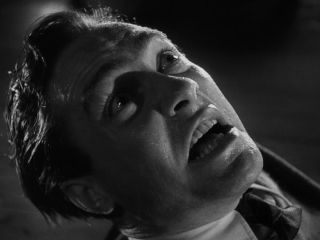The MacGuffin: News and Comment (07/Jun/2008)
(c) Ken Mogg (2008)
June 7
Gratitude to RM of our 'Seriously Alfred Hitchcock' Yahoo Group who this week reported how the ending of Stage Fright (1950) reminded him of André Breton's remark about surrealism: 'Inexplicably I saw the image of a man being cut in two by a curtain.' (In the same vein, didn't Breton once speak of how surrealism is like 'the chance meeting of an umbrella and a sewing-machine on an operating table'?) Of course this fits beautifully with both the surrealism of the film's opening scene - in which a theatre safety curtain rises to reveal a real-time view of St Paul's Cathedral, London - and the surrealism of the film as a whole. Based on our discussion of the film here lately, I suggested to the Group that Hitchcock was 'trying to sum up all reality in a parable about the stage (and the film being made about it) and people's duplicity, and the theme of illusion ...' We know that he put much thought and research into this film. In particular, as Richard Valley has shown ('Scarlet Street' #21, Winter 1996), he took the film's climax (a villain killed by a descending safety curtain - see frame-capture below) from a theatre-set novel by 'Edmund Crispin', 'The Case of the Gilded Fly' (1943). ('Edmund Crispin' was a nom-de-plume for [Robert] Bruce Montgomery, the English musician and film composer.) Moreover, Hitchcock was sufficiently impressed by Crispin's mystery novels featuring Gervaise Fen, an Oxford don turned amateur detective, that he also borrowed from them for the climax of his next film, Strangers on a Train (1951), with its out-of-control merry-go-round. The source in this case, for which Hitchcock paid a fee, was Crispin's delightful 'The Moving Toyshop' (1946). I'll say more about Hitchcock's borrowing in a moment. But first, I want to mention how well Hitchcock uses distraction in Stage Fright, perhaps because it fits the theatrical theme. For example, the film is almost half over when we learn that Charlotte (Marlene Dietrich) and her manager Freddie Williams (Hector MacGregor) are lovers - and that poor Jonathan (Richard Todd) has been Charlotte's fall guy, apparently duped into helping her merely to clear the coast for her and Freddie! (In turn, of course, Jonathan uses Eve (Jane Wyman) as his own dupe, when he goes on the run, though thereby having to admit he has been having an affair with Charlotte.) Structurally, what this piece of information does is further distract us from the possibility that Jonathan might be the killer of Charlotte's inconvenient husband, and that his story of Charlotte being the killer is a lie. (There's a foreshadowing here of Psycho.) Another instance of distraction is this. Mid-way through the film we see Jonathan slip into the theatre where Charlotte is performing onstage and head for her dressing-room. But Hitchcock doesn't want at this time to make Jonathan look weak, a flustered fugitive, and thereby arouse our suspicions that he may after all be the villain. So the film takes the unusual step of having Jonathan look directly into the camera as he moves from the wings towards the dressing-room. (This anticipates a moment involving the character Bob Rusk in Frenzy.) Now, finally, let's talk some more about the film's 'lying flashback' which has been much criticised, perhaps unjustly (as discussed here previously). Nobody, I think, has pointed out how this flashback is itself contained within a larger flashback beginning immediately after the opening shot of St Paul's Cathedral. Nor has anbody pointed out, to my knowledge, that exactly the same thing happens in another film about the theatre made the same year as Stage Fright, namely, Joseph L. Mankiewicz's All About Eve. In the latter, the main flashback begins straight after the opening scene, in which we have seen Eve (Anne Baxter) receive the Sarah Siddons Award for outstanding stage actress. The film's 'lying flashback' occurs a little later (but within the main flashback, note) when Eve tells the senior actress Margo Channing (Bette Davis) and several of her friends the sad story of her (Eve's) life to this point. (The fact that this scene anticipates Anne Baxter's flashback in Hitchcock's I Confess, and has almost certainly influenced it, is something I'll have to take up another time.) Like her namesake in Stage Fright, Mankiewicz's Eve is contrasted with the film's veteran actress, though we may infer that young Eve dreams of one day emulating, and even supplanting, her ... Also, late in Mankiewicz's film, Eve's story (like Jonathan's in Stage Fright) is shown to have been all a fabrication. (Parts of it even anticipate Marnie's lies in Marnie ...) Is all of this coincidence? I don't think so. I believe that Hitchcock and his screenwriter, Whitfield Cook, as part of their considerable research, had read the story on which All About Eve was based. That story, called "The Wisdom of Eve", by Mary Orr, appeared in 'Cosmopolitan' in May 1946. And in 1949 Orr's dramatised radio adaptation of her story was broadcast on NBC's 'Radio Guild Playhouse'.
This material is copyright of Ken Mogg and the Hitchcock Scholars/'MacGuffin' website (home page) and is archived with the permission of the copyright holder. |

